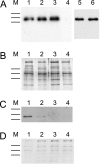Specific binding of the Xanthomonas campestris pv. vesicatoria AraC-type transcriptional activator HrpX to plant-inducible promoter boxes
- PMID: 16936021
- PMCID: PMC1636286
- DOI: 10.1128/JB.00795-06
Specific binding of the Xanthomonas campestris pv. vesicatoria AraC-type transcriptional activator HrpX to plant-inducible promoter boxes
Abstract
The pathogenicity of the plant-pathogenic bacterium Xanthomonas campestris pv. vesicatoria depends on a type III secretion system which is encoded by the 23-kb hrp (hypersensitive response and pathogenicity) gene cluster. Expression of the hrp operons is strongly induced in planta and in a special minimal medium and depends on two regulatory proteins, HrpG and HrpX. In this study, DNA affinity enrichment was used to demonstrate that the AraC-type transcriptional activator HrpX binds to a conserved cis-regulatory element, the plant-inducible promoter (PIP) box (TTCGC-N(15)-TTCGC), present in the promoter regions of four hrp operons. No binding of HrpX was observed when DNA fragments lacking a PIP box were used. HrpX also bound to a DNA fragment containing an imperfect PIP box (TTCGC-N(8)-TTCGT). Dinucleotide replacements in each half-site of the PIP box strongly decreased binding of HrpX, while simultaneous dinucleotide replacements in both half-sites completely abolished binding. Based on the complete genome sequence of Xanthomonas campestris pv. vesicatoria, putative plant-inducible promoters consisting of a PIP box and a -10 promoter motif were identified in the promoter regions of almost all HrpX-activated genes. Bioinformatic analyses and reverse transcription-PCR experiments revealed novel HrpX-dependent genes, among them a NUDIX hydrolase gene and several genes with a predicted role in the degradation of the plant cell wall. We conclude that HrpX is the most downstream component of the hrp regulatory cascade, which is proposed to directly activate most genes of the hrpX regulon via binding to corresponding PIP boxes.
Figures





References
-
- Bogdanove, A. J., S. V. Beer, U. Bonas, C. A. Boucher, A. Collmer, D. L. Coplin, G. R. Cornelis, H. C. Huang, S. W. Hutcheson, N. J. Panopoulos, and F. Van Gijsegem. 1996. Unified nomenclature for broadly conserved hrp genes of phytopathogenic bacteria. Mol. Microbiol. 20:681-683. - PubMed
-
- Bonas, U., R. Schulte, S. Fenselau, G. V. Minsavage, B. J. Staskawicz, and R. E. Stall. 1991. Isolation of a gene cluster from Xanthomonas campestris pv. vesicatoria that determines pathogenicity and the hypersensitive response on pepper and tomato. Mol. Plant-Microbe Interact. 4:81-88.
-
- Browning, D. F., and S. J. Busby. 2004. The regulation of bacterial transcription initiation. Nat. Rev. Microbiol. 2:57-65. - PubMed
-
- Busby, S., and R. H. Ebright. 1997. Transcription activation at class II CAP-dependent promoters. Mol. Microbiol. 23:853-859. - PubMed
-
- Canteros, B. J. 1990. Diversity of plasmids and plasmid-encoded phenotypic traits in Xanthomonas campestris pv. vesicatoria. Ph.D. thesis. University of Florida, Gainesville.
Publication types
MeSH terms
Substances
LinkOut - more resources
Full Text Sources
Molecular Biology Databases

